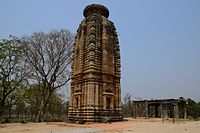Banda Deul
Geography

5miles
Reservoir
Hill
Location
Banda is located at 23°36′27″N 86°33′31″E / 23.6074°N 86.5587°E.
Banda is 1 km from Cheliyama, which contains the Radha Vinod temple with the most richly decorated terracotta carvings.
Note: The map alongside presents some of the notable locations in the subdivision. All places marked in the map are linked in the larger full screen map.
Banda Deul
There is a temple at Banda, which is described by the Archaeological Survey of India as a rekha deul of triratha variety in sandstone. The temple is richly decorated, the themes being creepers, scroll work and stylised chaitya window.The temple is datable to c. 11th century AD.
In 1872, the archaeologist J.D.Beglar came across this temple, then covered with deep vegetation in a forest. The area around the deul was cleared and it started attracting attention. It is not clear whether it was a Hindu or a Jain temple. The ground plan is star shpaed. Internally the cella is square with a rectangular Mukhamandapa. The temple consists of a single cell and it once had a mandapa.
The temple had a mandapa which has largely collapsed, However, eight pillars are still there supporting the cross beams. The temple has a water outlet with a makara (crocodile) head.
According to the List of Monuments of National Importance in West Bengal the old temple at Banda is an ASI listed monument.
Banda picture gallery
-
The deul at Banda with remains of the mandapa
-
The deul at Banda
-
Stone decoration
-
Crocodile head shaped water outlet
-
Sculpture on the wall of temple of Banda
-
Mandapa in front of the temple of Banda
References
- ^ "List of Ancient Monuments and Archaeological Sites and Remains of West Bengal - Archaeological Survey of India". Item no. 134. ASI. Retrieved 25 January 2020.
- ^ "District Census Handbook, Puruliya, Series 20, Part XII A" (PDF). Banda - Page 101: Brief Description of Places of Religious, Historical or Archaeological Importance and Places of Tourist Importance of the District. Directorate of Census Operations, West Bengal. Retrieved 23 January 2020.
- ^ "Old temple at Banda (locally known as deul)". ASI, Kolkata Circle. Retrieved 23 January 2020.
- ^ "Report of a Tour through the Bengal Provinces".
External links






